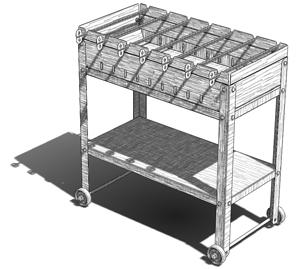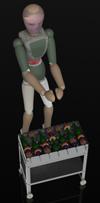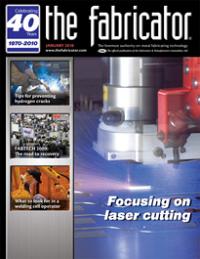Contributing Writer
- FMA
- The Fabricator
- FABTECH
- Canadian Metalworking
Categories
- Additive Manufacturing
- Aluminum Welding
- Arc Welding
- Assembly and Joining
- Automation and Robotics
- Bending and Forming
- Consumables
- Cutting and Weld Prep
- Electric Vehicles
- En Español
- Finishing
- Hydroforming
- Laser Cutting
- Laser Welding
- Machining
- Manufacturing Software
- Materials Handling
- Metals/Materials
- Oxyfuel Cutting
- Plasma Cutting
- Power Tools
- Punching and Other Holemaking
- Roll Forming
- Safety
- Sawing
- Shearing
- Shop Management
- Testing and Measuring
- Tube and Pipe Fabrication
- Tube and Pipe Production
- Waterjet Cutting
Industry Directory
Webcasts
Podcasts
FAB 40
Advertise
Subscribe
Account Login
Search
Putting 3-D CAD on the grill
A case study in product development
- By Gerald Davis
- January 15, 2010
- Article
- Shop Management
Our goal for the next several columns will be to bring the product concept shown in Figure 1 into virtual reality. This will involve some 3-D CAD modeling. Perhaps the most important themes will be planning and documentation.
Why is planning so important as the first step in 3-D CAD modeling? Because you can create a 3-D CAD model in so many different ways, you can streamline the decision-making process by anticipating how and why the model will be used before you start.
For example, the wheels shown in Figure 1 probably will be purchased. Our model does not necessarily need all of the detail required for manufacturing; it just needs to be visually representative of the wheel's appearance.
At the other extreme of modeling detail, we want the vent slide mechanism to work properly. So we need to model exactly how our custom-made parts will fit together. It will be useful to be able to see the parts in motion to ensure that no unexpected interference exists between the parts.
Early on we need to anticipate the documentation requirements as well. For the purchasing department, we'll need a bill of materials (see Figure 2). Manufacturing will need drawings and flat layouts for all of our custom-made parts (see Figure 3). For marketing, we may need some glamour shots to help promote the product (see Figure 4). We'll need to make an owner's manual so our customers know how to assemble the product (see Figure 5).
Product Definition
We are designing a small, charcoal-fired shish-kabob grill. The inspiration comes from a grill owned by Dimitri, who is my daughter-in-law"s cousin. He lives in the Ural Mountains and calls shish kabobs shashlik. That's going to be our product's name: the Shashlik Grill.
Dimitri's grill assembles without nuts and bolts. So, to avoid design infringements, we are going to bolt ours together. We're also going to make it out of stainless steel for durability.
From past experience we know that sheet metal warps when exposed to heat sources like charcoal. Because of this, we're going to invent a fire pan that isolates the warping from the main structure.
Other than that, our design strongly resembles Dimitri's—24 inches wide by 12 in. deep by about 25 in. tall, which includes the wheels.
For our prototype, we want to use as many off-the-shelf components as we can. We'll grab models from online resources whenever possible.
Reach for the Mouse
At this point we have a pretty good idea of what we want. In other words, our design intent is in place.
Planning is vital to having a good grasp of design intent. A mastery of design intent is a key element of efficient 3-D CAD modeling.
Now we have to make some decisions about how to model the grill. Nearly all of the documentation could be prepared with a drafting board—no computers required. However, the computer makes it easier to revise the design. A 2-D software package could do it, but the isometric drawings and exploded views are really tedious to prepare that way. My vote is to use a 3-D CAD software package to do this kind of modeling.
With the 3-D CAD software I'm using, I could model this as an assembly of parts, which creates a lot of individual files—or as a single multibody part. The cool thing about multibodies is that all of the parts appear in a single file on the hard drive.
However, I may use some of the hardware from this project in other designs, so it is to my advantage to model this as an assembly of parts. I have a spacious hard drive, and a clutter of file names won't be a problem.
Now comes the problem of file-naming conventions. Should I name the files to match their descriptions, such as "vertical symmetrical leg.sldprt" for the leg part? Or should I use part numbers to keep the file names from getting too long, such as "SG-001.sldprt"? Anybody know what a SG-001 is?
I like the brevity of using short file names. The bill of materials eventually will answer the question about what a SG-001 is. However, I don't know yet how many part numbers I'm going to need.
Fortunately, my 3-D CAD software lets me use a modeling technique called "virtual parts."
These critters behave like multibodies in that all of the files are contained in a single file. The parts are really easy to rename. If I choose to, I can convert the virtual parts into conventional external parts, which is handy if I want to use the same part on another project.
With all of that design intent in mind, let's get started with the modeling. Well, we'll have to do that next month. See you then.
Gerald Davis uses CAD software to design and develop products for his clients at Gerald Davis Design and Consulting.
About the Author
subscribe now

The Fabricator is North America's leading magazine for the metal forming and fabricating industry. The magazine delivers the news, technical articles, and case histories that enable fabricators to do their jobs more efficiently. The Fabricator has served the industry since 1970.
start your free subscription- Stay connected from anywhere

Easily access valuable industry resources now with full access to the digital edition of The Fabricator.

Easily access valuable industry resources now with full access to the digital edition of The Welder.

Easily access valuable industry resources now with full access to the digital edition of The Tube and Pipe Journal.
- Podcasting
- Podcast:
- The Fabricator Podcast
- Published:
- 04/30/2024
- Running Time:
- 53:00
Seth Feldman of Iowa-based Wertzbaugher Services joins The Fabricator Podcast to offer his take as a Gen Zer...
- Industry Events
Pipe and Tube Conference
- May 21 - 22, 2024
- Omaha, NE
World-Class Roll Forming Workshop
- June 5 - 6, 2024
- Louisville, KY
Advanced Laser Application Workshop
- June 25 - 27, 2024
- Novi, MI
Precision Press Brake Certificate Course
- July 31 - August 1, 2024
- Elgin,


































